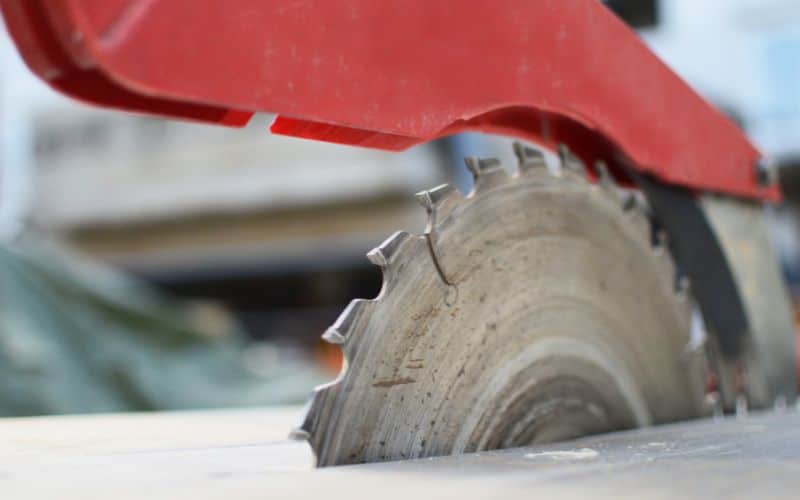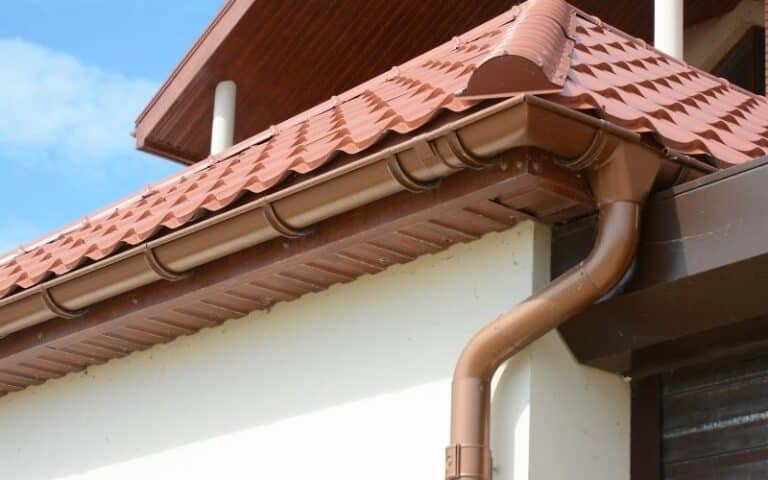Though the Dewalt table saw is a remarkable product, there have been instances where the blade won’t raise.
If you’ve experienced this, you probably wondered if you were doing it wrong or if the table saw was bad.
Fortunately, you’re here in the nick of time, so stick around and find out.
There are five major reasons your Dewalt saw blade wouldn’t raise. These are an accumulation of sawdust, rust, lack of lubrication, misalignment, and faulty mechanisms. However, greasing, cleaning, and other maintenance practices can easily eliminate these issues, so your saw blade regains normality.
This article contains all reasons hindering a Dewalt table saw blade from rising and further information on how to raise this blade.
You’ll also learn how to resolve other problems plaguing your blade and the steps to reset it.
Ready for a Roofing Quiz?
Why Won’t a Dewalt Saw Blade Raise?

There are five things to look to if you try to raise your Dewalt saw blade but fail. Let’s study each of these individually.
#1. Accumulation of Sawdust
It’s impossible to cut wood without sawdust spreading into the atmosphere and its particles resting on equipment.
So, in the cutting process, sawdust spreads and accumulates on the saw alongside dirt and other particles.
Initially, this will pose no problem, but as it builds up, it will clog the locomotive parts and prevent the blade from rising.
In this situation, you have to carry out a thorough cleaning of the motor, saw cabinet, and all other components.
#2. Rust
You may wonder how your Dewalt table saw blade would develop rust when you’re so cautious when using water.
But the truth is that rust isn’t always a result of water; moisture concentration may also lead to rust.
Rust causes friction that hinders mobility. Hence, you will have to resolve this by applying a rust removal spray to the affected part.
So, spray the rust removal, wait a few minutes and then clean it off.
Remember that some rust removal sprays are more effective than others, so the outcome of this step depends on the product you use.
#3. Lack of Lubrication
If the mechanism controlling blade elevation and tilting is dry, there will be friction.
The result of this will be difficult raising the blade hence the importance of regular lubrication.
However, use a dry lubricant, as greasy ones will collect sawdust and dirt.
#4. Misalignment
If your blade alignment isn’t right, it won’t raise. Hence, it would help if you focused on attaining a proper blade alignment for operational ease.
#5. Faulty Internal Mechanism
In this case, the issue relates to the arm getting stuck or its elevating mechanism suffering breakage. So, you should check the atm for any breakage or obstruction and give it a fix.
Here are some additional maintenance steps:
- Polish the table with automotive wax.
- Clean the saw blade’s plastic parts.
- Use gum remover & pitch to clean your Dewalt saw’s cutting blade.
You should note that a Dewalt saw blade not raising isn’t uncommon or a problem peculiar to the brand. It’s rather a generic problem of table saws.
So, this issue should not make you doubt the brand’s image or products.
You should also remember that proper maintenance will prevent you from experiencing this issue again.
What is the Proper Way to Raise a Dewalt Saw Blade?
People often make assumptions when handling tools, and the result won’t be plausible when it goes wrong.
Hence, knowing the right way to handle a Dewalt saw blade is important. So, here’s how to raise the Dewalt saw blade for height adjustment.
- First, begin by finding the height adjustment knob.
- Identify the horizontal rod which connects to a vertical rod beneath the tabletop with sprockets.
- The height adjustment knob is on the horizontal rod.
- Look on the vertical rod below the sprocket to find a nut.
- Hold the adjustment knob and screw the other nut using a 17 mm wrench.
If, after reading this, you realize that you have been handling your blade in the wrong way, you should adhere to the procedure above.
If you do, you’ll notice a significant amount of ease when using the Dewalt table saw blade.
Proper handling can even eliminate the issue of the blade’s inability to raise and many more.
However, if your blade still won’t budge after trying this, you should clean out your gears as they may be a build-up preventing its movement.
Alternatively, if the model of your Dewalt table saw blade has a wheel, you can use it to adjust the blade’s height.
You have to turn the wheel clockwise to raise the blade and counterclockwise to lower the blade.
If you want to set a specific blade height, you can use a combination square. Place it upright beside your blade.
Then, rotate the wheel while checking your combination square to verify that it’s at the exact measurement you need.
How to Reset a Dewalt Saw Blade?
Suppose your Dewalt table saw blade stops functioning or begins agitating with seemingly unresolvable issues.
Sometimes, all it takes to normalize is a simple overload reset. Hence, you should always remember the steps for resetting your Dewalt saw blade.
It’ll come in handy, maybe when you least expect it. Here are the steps below;
- Turn off the saw before you begin to prevent accidents and mishaps.
- Disconnect it from electrical energy.
- Please wait for a minute, then plug it back in.
However, if you’re looking for a power loss reset switch, the Dewalt manual states that there is an automatic reset procedure.
There is a thermal overload switch in the form of a red button on the motor. Look above the on/off switch.
Pressing this switch should reset your Dewalt table saw blade and restore its functionality.
Do not hesitate to reset your Dewalt table saw blade if it displays issues you can’t handle. After all, these steps are easy-peasy.
But if a reset doesn’t seem to cut it, you should contact a technician for further help.
Read More: Joint Compound Flashing Thru Paint (Read This First)
4 Common Problems of Dewalt Saw Blade and Their Solutions
The Dewalt table saw blade would develop certain faults as an electrically driven tool.
Hence, as a Dewalt saw owner, you should be familiar with its common possible problems even before it starts acting up.
That way, you’ll understand the problem, and resolving it won’t be challenging.
So, let’s venture into common Dewalt saw blade problems and acquaint you with their solutions.
#1. Dewalt Table Saw Refuses to Turn On
A common complaint from users is that the Dewalt saw isn’t turning on.
This situation is a great hindrance because you won’t be able to do anything with a nonfunctional blade.
There are three major causes for this issue which are:
- A low battery.
- The lock-off button.
- Wiring and other power-related issues.
Solution
Getting the solution is as easy as tackling the faults. So, firstly, always ensure to charge your Dewalt table saw fully.
Once it blinks red light, it’s a sign indicating the need for a charge. Secondly, you must release and activate the lock-off button before using your saw.
Check the trigger above to find this button. You can release the trigger to activate the lock-off button.
Lastly, if there’s any damage to the saw’s wiring harness, you must fix it. If there is none, verify that the outlets and switch are working.
If they are, you should check the power cord and motor drive. Then after identifying the faulty component, repair or replace it based on the degree of damage.
Related: Mastic On Cement Board (All You Need To Know)
#2. Stuck Trigger
It is not unusual for your Dewalt saw’s trigger to get stuck or hang in the downward position.
Alternatively, it may hang upwards and refuse to budge when you pull it down.
This occurrence will prevent your table saw from starting. However, I have for you to try:
Solution
Please look closely at your trigger and scrutinize it to ensure nothing is in its locomotory way. If there is an obstruction, take it out.
Also, check the lock-off button and confirm that it is properly set.
If everything is in place and your trigger is still stuck, your next action should be to replace the trigger.
#3. Dewalt Table Saw Motor Overload
One of the prevalent issues which Dewalt saw users face is motor problems. The most common of these is an overloaded motor.
An overloaded saw motor lacks continuity and therefore creates a functionality hindrance.
Solution
To check if your saw’s motor is overloaded, use a multimeter. Depending on your test result, you may either replace the overload or try the overload reset.
Related: Code Clearance Between Siding And Patio!
#4. Unusual Noises and Smell
Loud noises and a burning smell from your Dewalt saw are mostly signs of motor problems.
And motor problems in this scenario are related to dirt, dust, and other particles.
One major particle is sawdust which accumulates during the process of wood cutting and spreads through the motor housing, gears, wiring, arbor assembly, fans, and other parts.
Additionally, wear and tear or damage to locomotive parts of your Dewalt saw can cause these strange noises.
Solution
You have to maintain and clean the saw’s parts thoroughly. But first, turn it off and unplug it from its power source before you begin.
After doing this, you can disassemble the saw’s motor housing and all clogged or dusty parts.
However, you mustn’t use cleaning agents or chemicals as they can cause further damage.
Also, check for worn-out parts, missing or loose screws, worn-out belts, etc. If you find any, change and replace them accordingly before recoupling your saw.
There are other issues, though not as common as the first.
Let’s explore these cut issues and their solutions in a tabular form.
| Dewalt Table Saw Problems | Solutions |
|---|---|
| The saw doesn’t cut very deep | Adjust the blade height using the depth adjustment knob. |
| The cuts are angular. | Loosen the knob, level the trigger, and tighten the knob. |
| Wiggly saw blade. | Use a blade wrench to tighten the blade by screwing the washers. |
| A crack in the blade. | Get a new blade. |
| The blade no longer cuts easily. | Sharpen or change your Dewalt saw’s blade. |
| The saw doesn’t move but remains on. | Check for obstructions in the plastic blade guard and clear them. |
| Overheating. | Get an appropriate blade that suits the material you’re cutting. |
Please note that the presence of issues doesn’t spell out doom for any tool. Hence, the Dewalt table saw is still a good and highly efficient blade to purchase.
Conclusion
The Dewalt table saw blade is efficient and possesses acute precision, accuracy, and capacity. However, users complain of issues like the saw blade not raising.
Resolving this issue involves gaining proper knowledge on how to raise the blade and adhering to certain maintenance practices.
These practices also help to keep other issues at bay. However, if you can’t apply them effectively, you should visit a technician to prevent further damage.






